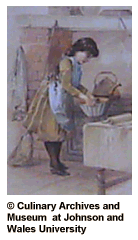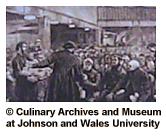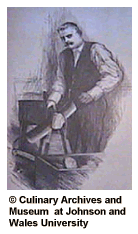|
1910-1914 1910 Return of Halley's Comet (sale of anti-comet pills); Land speed record established (133 mph); 1911 Chili con carne and tamales first canned; Stainless steel patented; First trans-continental plane flight (82 hours); 1912 Titanic disaster in the North Atlantic; Cellophane perfected; First self-service grocery stores (California); Vitamin A discovered; Girl Guides (later Girl Scouts) founded; 1913 Cork bottle cap seals improved; 1914 Panama Canal opened; George Washington Carver's peanut experiments; Commercial frozen fish process developed; Passenger pigeon exterminated; Railroad tank trucks used to transport milk; World War I begins in Europe. 1915-1919 1915 Processed cheese introduced; Pyrex glass developed; First successful commercial motion picture (Birth of a Nation).; 1916 Fortune cookie invented (Los Angeles, California); Mechanical home refrigerator marketed; 1917 United States enters World War I; Bolshevik Revolution (Russia); 1918 Canned tomato sauce introduced; Electric food mixing machine patented; Pop-up toaster patented; World War I ends (11th hour of the 11th day of the 11th month); French-dip sandwich invented; Spanish influenza epidemic (500,000 deaths in U.S.); 1919 League of Nations formed; Homogenized milk sold commercially; 18th Amendment (Prohibition) adopted. 1920-1924 1920 Prohibition implemented; Automatic doughnut-making machine developed; Boysenberry developed; 1921 Processed cheese introduced in foil-wrapped loaves; Iodized salt introduced; Stainless-steel flatware introduced; 1922 19th Amendment passed (voting rights for women); Insulin developed; 1923 First commercial sale of tomato juice; Milky Way candy bar introduced; First American supermarkets (California; New York); 1924 Caesar salad created (Tijuana, Mexico); First effective chemical pesticide introduced. |
|
1925-1929 1925 Automatic potato-peeling machine developed; Scopes Monkey trial (Dayton, Tennessee); 1926 Daily dining car service implemented on the Santa Fe railroad; First successful flight over the North Pole; 1927 First solo flight across the Atlantic (Charles Lindbergh); Wonder Bread introduced; Kool-Aid invented; First successful demonstration of television; 1928 Commercial bread slicer perfected; First woman to fly across the Atlantic Amelia Earhart); Mickey Mouse introduced (Walt Disney); First scheduled television program; 1929 Stock Market crash; Milk in paraffin-lined paper cartons introduced; Coin-operated vending machine patented. 1930-1934 1930 Unprecedented drought (South and Midwest states); Sliced bread introduced commercially; Breadlines in major U.S. cities; Empire State Building completed; Bank panic (hundreds of American banks close); First successful round the world flight; 1932 Corn chips introduced; Route 66 completed (Chicago to Los Angeles); 1933 Prohibition repealed; Vitamin D fortified milk introduced; Tennessee Valley Authority Act (TVA) passed by Congress; Farm Credit Act passed by Congress; Roosevelt elected President; Civilian Conservation Corps (CCC) inaugurated; 1934 Terrible dust storms; Taylor Grazing Act passed to prevent soil erosion. 1935-1941 1935 Terrible dust storms continue; Works Progress Administration (WPA) instituted; Social Security Act; Pan American Clipper flights serve first hot meals to passengers; 1936 Boulder Dam (Hoover Dam) completed; Kitchen blender invented; Supermarket shopping cart developed; Spam introduced nationally; Golden Gate Bridge completed (San Francisco, California); Spanish Civil War; 1938 First drive-in hamburger stand; Teflon discovered; First sales of Girl Scout cookies; 1939 Pre-cooked frozen foods introduced; First widespread agricultural use of DDT; Discovery of Rh factor in human blood; Inauguration of trans-Atlantic commercial airline flights (Pan American); World War II begins in Europe; Nylon stockings first sold in United States; 1940 Bottle glass (Duraglas) developed; Freeze-drying process for food preservation developed; 40 hour work week implemented; McDonald brothers open drive in hamburger stand (southern California); 1941 United States enters World War II. |
|||
|
|||||
| Exhibit Home | Further Resources | Library Home |
 Printed mention of hardtack, or hard biscuit made with flour, water, and no shortening or yeast, first appear in 1833? Hardtack was a basic food of sailors, and became a military ration staple during the American Civil War.
Printed mention of hardtack, or hard biscuit made with flour, water, and no shortening or yeast, first appear in 1833? Hardtack was a basic food of sailors, and became a military ration staple during the American Civil War.  While the origin of pizza is obscure, and may have been invented in ancient Greece, the pizza that Americans recognize today was developed in 1905 in New York City? A dish that resembles pizza was common in Roman times and called focaccia. The word pizza comes from the Latin, picea, meaning -- black ashes from the floor of the fireplace.
While the origin of pizza is obscure, and may have been invented in ancient Greece, the pizza that Americans recognize today was developed in 1905 in New York City? A dish that resembles pizza was common in Roman times and called focaccia. The word pizza comes from the Latin, picea, meaning -- black ashes from the floor of the fireplace.  Political slogans in America sometimes have had a food-related focus? William McKinley campaigned in 1896 on the concept he would promise a "full dinner pail." Herbert Hoover campaigned in 1928 and used the slogan... "a chicken in every pot.
Political slogans in America sometimes have had a food-related focus? William McKinley campaigned in 1896 on the concept he would promise a "full dinner pail." Herbert Hoover campaigned in 1928 and used the slogan... "a chicken in every pot.  Thomas A. Edison attributed his longevity to a diet? He adopted a pattern where he drank two glasses of milk at each meal. Edison reported that he did not always eat sardines, but varied his diet with lamb chops and vegetables. When asked about health, Edison replied that the quantity of food he ate was very small... just enough to keep his weight constant.
Thomas A. Edison attributed his longevity to a diet? He adopted a pattern where he drank two glasses of milk at each meal. Edison reported that he did not always eat sardines, but varied his diet with lamb chops and vegetables. When asked about health, Edison replied that the quantity of food he ate was very small... just enough to keep his weight constant.  The wartime advertising campaigns to save 'sugar, fat, and wheat,' taught millions of Americans about food and nutrition? Many Americans learned for the first time there were differences between potatoes and tomatoes, that some foods were similar to each other, while others were not.
The wartime advertising campaigns to save 'sugar, fat, and wheat,' taught millions of Americans about food and nutrition? Many Americans learned for the first time there were differences between potatoes and tomatoes, that some foods were similar to each other, while others were not. 